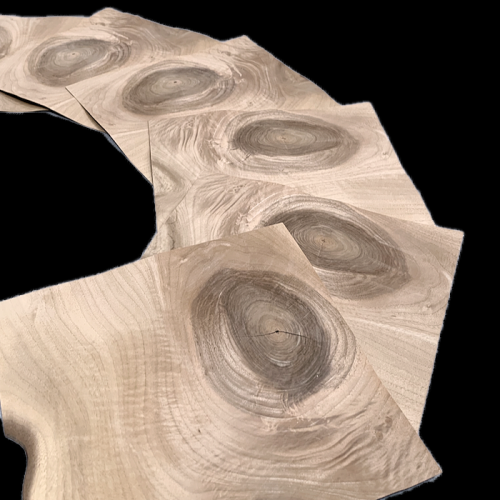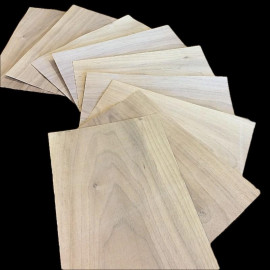
Knotty Walnut XXL Small-size Veneers
Knotty Walnut XXL Small-size Veneers
Genuine wood sliced-veneer sheets.
Selected single veneers, no sequence.
Fix length of 30 cm long.
Width: From 22 to 32 cm, depending on availability.
Thickness: 0.6 mm.
Sold by the sheet.
Warning: Carefully read the full description of these veneers.
Knotty Walnut XXL Small-size Veneers
Genuine wood sliced-veneer sheets.
Selected single veneers, no sequence.
Warning:
A Knotty Walnut is a French walnut featuring one or more large knots. These knots are typically pierced and split at their center. It is distinct from a burl.
Dimensions:
Fix length of 30 cm long.
Width: From 22 to 32 cm, depending on availability.
Thickness: 0.6 mm.
Sold by the sheet.
Measurement scaling:
The width is rounded to the covered centimeter, for example, 15.8 cm, giving 15 cm.
Species:
Common names:
Walnut, French walnut, European walnut.
Note:
According to Pliny the Elder, "Juglans" comes from "Jovis Glans," meaning "Jupiter's acorn."
Botanical name:
Juglans Regia.
Origin:
France, Northern Europe, Eastern Europe, and Asia Minor.
Appearance:
French walnut is a rather turbulent wood with a pronounced natural character.
Several specialties are particularly sought, such as swirl, a root section of the trunk offering a vibrant grain pattern, or burl, a growth of hundreds of small pin-knots.
Unlike American walnut, which is dark with purplish hues, French walnut has a brown base color. With the patina of time and wax, its color will take on a superb depth of shine.
Properties:
Weight: 640 kg/m³, average weight at 10-12% moisture content.
Janka hardness: 5410 Newton, for comparison: Oak is 4980 N and Poplar is 1650 N.
Elasticity: 10.81 Gigapascals, for comparison: American maple is 12.62 GPa and Poplar is 9.75 GPa.
Tensile strength: 111 Megapascals, for comparison: US maple is 109 MPa and Oak is 47.3 MPa.
Uses:
This wood is appreciated in the manufacture of furniture, in decoration, in the dashboards of luxury cars, in guitar making, and in the restoration of old radios.
Product Description:
Genuine wood-sliced veneer sheets.
These veneers are raw without a finish or any fleece back.
The veneer surface is similar to plane wood. However, it will be preferable to forecast a light sanding after gluing.
The veneers are offered here as wood-sliced sheets of one and unique thickness.
Both faces of these veneers are the same, without fleece back, without glue.
Even if the veneer's sides had been cut relatively straight, it isn't a precise parallel clipping; some veneers may have kept the decreasing shape of the tree, wider at the bottom end and narrower at the top end.
Very occasionally, some veneers' sides have traces of unclipped wane, but our veneers are measured at the narrowest, as explained in the paragraph "Dimensions."
As genuine natural wood, all finishing products are acceptable as long as they are meant for wood use.
The choice of the finished product must be consistent with the final usage realization.
Use of the veneers:
Cutting:
Veneers can be easily cut with a utility knife.
For straight cuts, the best results are obtained with a veneer saw.
Use a fretsaw, scalpel, or veneer knife for curved cuts.
Always allow for a slightly larger veneer sheet than your intended surface. This will allow you to adjust the size after gluing for a clean finish.
A flush trimmer can also be used to trim the veneer after gluing.
When cutting with a utility knife or veneer knife, it is best to cut with the grain of the wood. To check this, run your finger along the edge of the sheet. The direction that feels smoothest is the ideal direction for cutting.
Gluing:
Several types of gluing are possible.
With vinylic glue, the veneer is pressed over its entire surface.
With neoprene glue for all surfaces, especially non-porous surfaces, by applying two coats of glue and marouflage.
With animal glue such as hide, sinew, or bone glue.
With vinyl glue and an iron, apply two thin coats of glue to each piece. This technique should only be used if other gluing techniques are not possible.
Sanding:
Veneers and all our products are genuine wood and can be sanded according to their thickness.
Please do not use a belt sander, regardless of the thickness of the veneer, as this could pierce it.
With a 0.6 mm veneer, lightly sand with 120 grit and then finish with 180 or 240 grit. With an orbital sander, 180 grit is already sufficient for most applications.
Finishing:
All finishing products generally used for wood are suitable for finishing our products. For example, you can use a varnish, wax, paint, or oil.
However, ensure that the product you want to use is compatible with the final use of your creation.
Photos:
To keep the cost of these products as cheap as possible and contrary to other veneers on this website, the pictures of small-size veneers do not represent the available stock.
More information:
Please look at our TUTORIALS; you might find some valuable tips.
Please get in touch with us by email or phone for any additional information.
Data sheet
- Species
- Walnut
- Thickness group
- Standard
- Width group
- XXL width
- Grade
- Swirl
You might also like
 English
English








